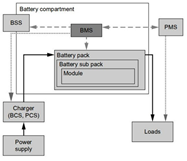Entering a new era for electrical vessel on inland waterways
DOI:
https://doi.org/10.25043/19098642.230Keywords:
battery, fuel-cell, hybrid, safety, operationsAbstract
The shipping industry is moving towards quickly decarbonizing its assets. There is also a growing demand for new urban transportation (passengers, building materials, and equipment) with zero-emission propulsion. Zero-emission propulsion is available today for sustainable transport. The common size of inland navigation vessels offers the opportunity to implement innovative technologies earlier than seagoing ships. There is clearly a wide range of solutions available, with their own set of pros and cons. Batteries and fuel cells are part of a growing list of solutions to carbon-neutral or zero-emissions shipping. They become a strong choice and can be successfully combined with alternative fuels. As a result, electric and hybrid vessels are currently among the most important developments in the inland navigation sector. Bureau Veritas, as one of the major classification societies, proposes a brief review of state-of-the-art electrical solutions, considering available technologies, safety constraints and operational challenges, bringing to light its experience in electrical vessels, both in new constructions and conversions as well as in vessels in service. Although many parameters must be considered, the conclusion confirms that there are electrical solutions already suitable for a range of vessels and it is also possible to pencil the near future in association with new infrastructure and supply chain.
Downloads
References
Bureau Veritas Rules and Guidelines (available at: https://marine-offshore.bureauveritas.com/rule-notes-and-guidance-notes):
- Rules for the classification of inland navigation vessels, NR217, Jun 2021.
- Rules for the classification of steel ships, NR467, Jan 2023.
- Certification scheme of materials and equipment for the classification of marine units, NR320, Jul 2022.
- Gas-fuelled ships, NR529, Jul 2022. - Ships using Fuel Cells, NR547, Jan 2022
- High-voltage shore connection system, NR557, Jan 2010.
- Methanol & ethanol fuelled ships, NR670, Aug 2022.
- Ammonia-fuelled ships, NR671, Jul 2022
- Requirements for survey of materials and equipment for the classification of inland waters-operated vessels / units, NR544, Nov 2021.
- VNF, Voies navigables de France, Direction du Développement, 62408 Béthune, France : "Les cahiers techniques de BATELIA" (Bureau d'Assistance Technique et Logistique pour les Industriels et Artisans), including:
CAHIER TECHNIQUE N°1, Propulsion hybride pour bateaux fluviaux » - Édition avril 2018.
CAHIER TECHNIQUE N°2, Propulsion hydrogène pour bateaux fluviaux » - Édition janvier 2020.
- "Hydrogen Insights - A perspective on hydrogen investment, market development and cost competitiveness" - Hydrogen Council, McKinsey & Company - February 2021.
- "What role does hydrogen have in the future of electric mobility?", Prof. Werner Antweiler, Ph.D., University of British Columbia - Sep.28, 2020.
- Electric & hybrid marine technology international at: https://www.electrichybridmarinetechnology.com/
- "Creating a rule framework for the green revolution in shipping industry" Internal & territorial waters, Ship Science & Technology, vol.15, nr.19 (page 71) - July 2021 - Jean Michel Y. Chatelier. https://doi.org/10.25043/19098642.222
- "Shaping a better maritime world", Matthieu de Tugny, President Bureau Veritas Marine & Offshore - 2022.
- "Alternative fuels outlook for shipping", White paper, Bureau Veritas - Sept. 2022.
- "Inland waterways fast-track green transport", Bureau Veritas magazine - Oct.11, 2022.
- "Fuel cells - tailor-made for inland waterways?", Bureau Veritas magazine - July 12, 2022.
- "Decarbonizing ports for the 21st century", Bureau Veritas magazine - June 2, 2022.
- "What well-to-wake decarbonization means for shipowners", Bureau Veritas.
- "Power in port", Bureau Veritas magazine - April 1, 2022.
- "Regulating hydrogen fuel for inland navigation vessels", Bureau Veritas magazine, Dec. 22, 2021.
- "What sustainability means for inland navigation vessels", Bureau Veritas magazine, May 10, 2021.
- "Client corner: battery-powered ships FAQ", Bureau Veritas magazine, Feb.24, 2021.
- "Entering a new era for battery-powered ships", Bureau Veritas insight, June 22, 2021.
- "Future marine fuels: pathways to decarbonization", Bureau Veritas insight, Oct. 7, 2019.

Published
How to Cite
Issue
Section
License
Copyright (c) 2023 Cotecmar

This work is licensed under a Creative Commons Attribution 4.0 International License.
The authors who publish in this Journal certify that:
- The work submitted for publication in The Ship Science and Technology journal, was written by the author, given that its content is the product of his/her direct intellectual contribution.
- All data and references to material already published are duly identified with their respective credits and are included in the bibliographic notes and quotations highlighted as such.
- All materials submitted for publication are completely free of copyrights; consequently, the author accepts responsibility for any lawsuit or claim related with Intellectual Property Rights thereof, Exonerating of responsibility to The Science and Technology for the Development of Naval, Maritime, and Riverine Industry Corporation, COTECMAR.
- In the event that the article is chosen for publication by The Ship Science and Technology journal, the author state that he/she totally transfers reproduction rights of such to The Science and Technology for the Development of Naval, Maritime, and Riverine Industry Corporation, COTECMAR.
- The authors retain the copyright and transfer to COTECMAR the right of publication and reproduction of the work which will be simultaneously subject to the Creative Commons Attribution License (CC -BY) , which allows the license to copy, distribute, display and represent the work and to make derivative works as long as it recognizes and cites the work in the manner specified by the author or licensor.
- For more information about the Creative Commons Attribution License (CC -BY) and his use and scope, please visit the following web page https://creativecommons.org/licenses/by-sa/4.0/legalcode








